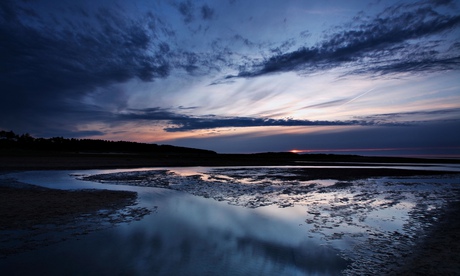
Sunbathing bores me, I'm too old to build sandcastles, and I neither swim nor surf. For me, the inevitable summertime trip to the beach is not about any of these things; it's an opportunity to inhabit, however briefly, the margin where land and sea engage in a constant, ever-changing relationship that is one of the great drivers of life on, and the life of, the planet. It's a zone of interchange between the three great planetary ecosystems of earth, air and ocean and one which played a crucial role in the evolution of life itself. A trip to the seaside is an opportunity to contemplate the sea in all its multifaceted glory.
However, if, like me, you're no expert, you'll need a guide to take along, someone who knows the science of the sea and can communicate it clearly and alluringly. You're unlikely to find anything better than Rachel Carson's 1951 The Sea Around Us, the first, and still perhaps the best science bestseller. It wasn't her first attempt at capturing the oceans between the covers of a book; 10 years earlier she had published Under the Sea Wind, a set of short stories in which sea life is narrated through the eyes of birds and fish. This first book was a critical but not a commercial success and disappeared until the success of The Sea Around Us brought it back into print.
The second book is a quiet tour de force. Carson avoids the temptation to patronise either the reader or the world she is bringing to life. There is none of the wallowing in anthropomorphic inaccuracy that mars much popular nature writing and the science is lucidly explained without leaving out the hard bits. The reader is immersed in a new and wonderful world, one where everything really is connected to everything else. "There is," as she writes, "no drop of water in the ocean, not even in the deepest part of the abyss, that does not know and respond to the mysterious forces that create the tide." This sense of the sea and all its constituents as part of an interrelated system infuses the entire book.
By giving clear expression to the interrelatedness of land, air, sea and the pull of sun and moon, The Sea Around Us transcends mere nature writing and becomes a work of ecology. This is no accident; Carson is concerned that we take action to protect these delicate ecosystems and realises that to encourage this she needs to help us understand their importance to us and to everything else. Knowledge here is not celebrated just for itself but as a key to what Buddhists might call "right action". Her quiet call to arms is summed up in these words: "It is a curious situation that the sea, from which life first arose, should now be threatened by the activities of one form of that life. But the sea, though changed in a sinister way, will continue to exist; the threat is rather to life itself."
As a youngster, Carson wanted to be a writer, a poet even. University and a job with the United States Fish and Wildlife Service turned her into a marine biologist with a passion for the sea and an urge to share it. In The Sea Around Us she marries her early ambition with her skills as a researcher and synthesiser. She ranges over the fields of geology, palaeontology, biology and human history, combining the scientist's eye for detail with the poet's feeling for rhythm and clarity of expression. The book's commercial success enabled Carson to leave her job and dedicate her life to independent research and writing. One result of this independence was The Edge of the Sea, the book that completed the Sea trilogy and which moves the beach walker's gaze from the sea before them to the sand and stones beneath their feet. The second outcome was the writing of Silent Spring, Carson's most famous book and one which was instrumental in both the banning of DDT and the crystallisation of 1960s environmentalism. Without The Sea Around Us, Silent Spring might never have been written.
Inevitably in a book that is over 60 years old, some of the science is outdated. As a scientist, this is something that Carson would surely both have anticipated and welcomed; an exemplification of science's great strength, its insatiable curiosity. But this is a minor quibble; The Sea Around Us is, quite simply, a masterpiece of ecological writing. Reading it will ensure that you never look at the sea in the same way again.

